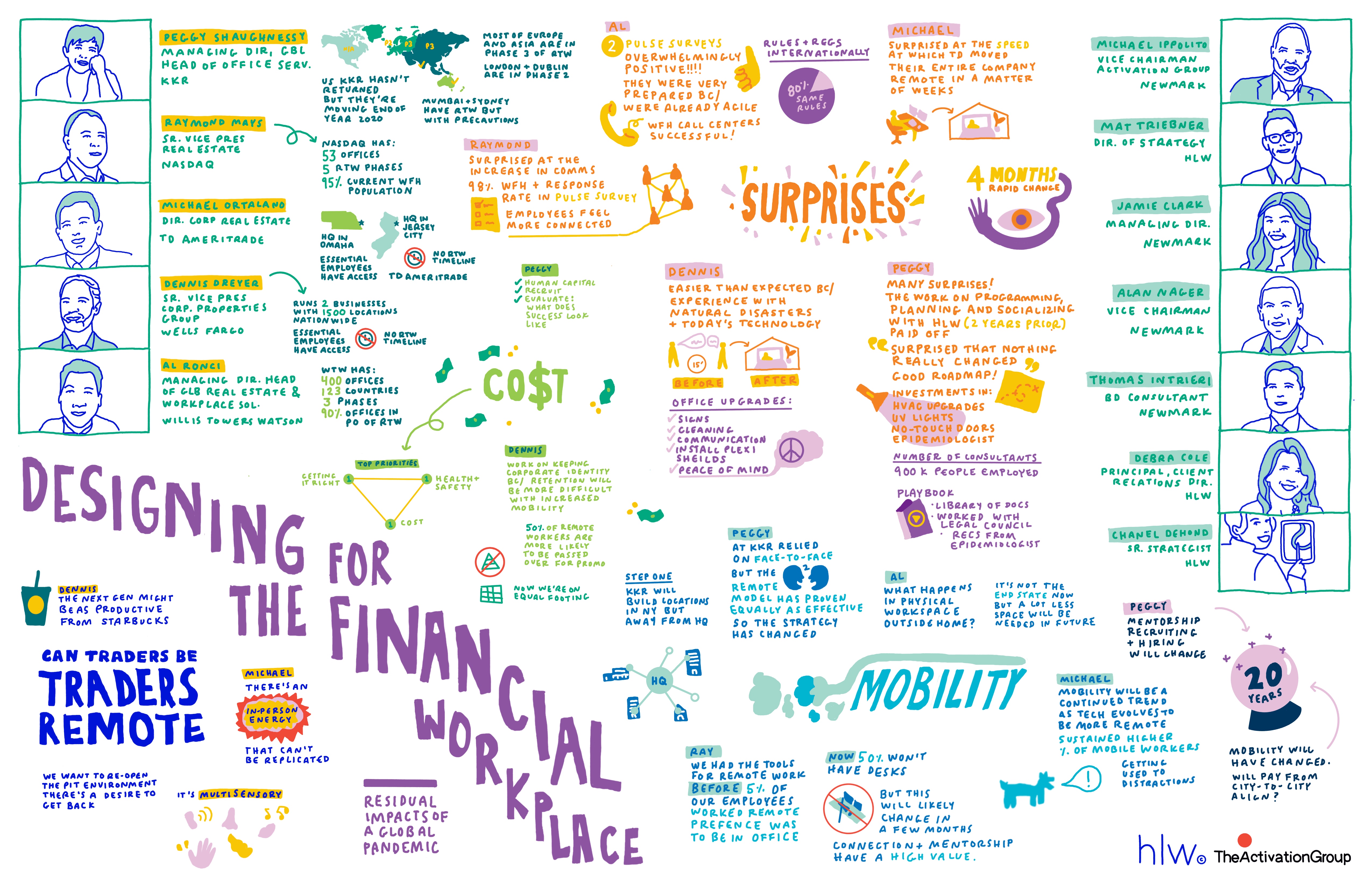
The Future of Finance
Designing for the Financial Workplace
The complete visual notes are at the end of this article.
On July 7th, HLW and the Newmark Activation Group hosted a virtual get-together with a group of leaders from various financial services companies. The evening’s discussion focused on what’s been working well in their respective organizations over the last few months and what they expect to see in the future of their workplaces. Here is what we learned.
Companies proactively prepared for change and in so doing, accelerated their crisis response.
Each participant indicated that their respective organization surveyed their employees during the ongoing work from home period. Encouragingly, organizational performance scores were consistently high, and employees have been staying relatively well engaged. Participants identified several reasons for this. In recent years, many organizations in the financial sector have been building new levels of flexibility into their workplace strategies. For some, particularly companies located around Wall Street, these changes began nearly a decade ago, in the aftermath of Superstorm Sandy. One participant discussed advanced preparations for the next natural disaster and how their organization has built capacity for resilience, which came to fruition in the current shutdown. Other participants discussed how their companies have gone agile in the last few years across business functions, resulting in an easier transition to remote work over recent months. Finally, everyone was unanimous in their recognition of the importance of leadership reinforcing change and the need to stay flexible in how people work.
The range of strategic changes reflects the breadth and complexity of business offerings in the sector.
The financial service sector is complex and diverse. Each participant supports a complex organization with functions that range from call center operations to high touch client engagements, and whose lines of business include trading, hedge funds, investment banking, commercial banking, retail banking, and insurance, to name a few. Furthermore, two of the participants represented companies currently going through a merger or acquisition. The global nature of the participants’ real estate portfolios means addressing different cultural and regulatory environments across the world. This introduced further variability in dealing with compliance matters with teams working remotely, or how to safely plan to re-open offices subject to specific local health requirements. The panel agreed that one key to success in managing this complexity is having real estate and corporate services teams play the role of information aggregator for their organizations. This role means reviewing and compiling relevant local or industry-specific information, making it available throughout the organization, and helping users understand and apply that information.
Mobility is here to stay, but its proliferation will shape the sector in a positive way.
While each participant indicated that their company is making plans to return to the office, they will each be returning to a new reality. To begin, companies already in the midst of redesigning their spaces are now making minor changes to layouts and infrastructure to respond to wellbeing demands. However, bigger questions focus on identifying the office’s purpose in the future workplace ecosystem. Some aspects of financial services, such as trading and client relations, rely on a hands-on mentorship model for newer employees, which is more difficult to replicate in the virtual environment. In these cases, offices will likely be organized to provide an environment conducive to learning and mentorship, while enabling increased mobility for those with more predetermined functions. These organizations recognize that mobility and flexibility have the potential to broaden their geographic catchment area for human capital. Likewise, participants understand that defining the criteria for the next generation of workers will have a long-term impact on their real estate portfolios and broader business strategies.
In conclusion
Ultimately, each participant of the event remains focused first and foremost on providing a safe workplace, supportive of worker wellbeing. Everyone is conscious of avoiding rushed decisions that will have detrimental long-term consequences. Instead, they are each using this time to pilot alternative ways of working with the hopes of yielding a more supportive and engaging environment for a future generation of workers, which reflects the changing dynamics of the labor market and the post-pandemic shape of our cities.
Peter Bacevice, PhD – Director of Research, HLW
Alex Dunham, AIA, NCARB – Director of Workplace, HLW
Visual Notetaking by Chanel Dehond – Senior Design Strategist, HLW



